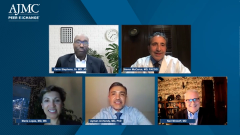
A Paradigm Shift in Treatment of UF and Endometriosis
Steven McCarus, MD FACOG highlights the shift away from surgical treatment toward medical therapy in UF and endometriosis.
Episodes in this series

Neil Minkoff, MD: Let me bring Dr Steven McCarus into the conversation. In a couple of sentences over the last few minutes, both of our other panelists have mentioned surgical options. You’re the chief of gynecological surgery, so let’s bring you in to talk about that. If we’re talking about things like uterine fibroids or heavy menstrual bleeding, there’s a pretty significant clinical burden, but it feels as if the movement has been away from surgical treatment toward nonsurgical treatment to medical treatment. I was wondering if you could touch on some of those things or specifically how they might differ from heavy menstrual bleeding as opposed to endometriosis.
Steven McCarus, MD, FACOG: The clinical burden on endometriosis and uterine fibroids as far as surgery is real. Surgery is risky. It interferes with someone’s daily activities. It may create a burden not only on the patient but also on the hospital and surgeon. There’s been a paradigm shift. I’m happy to say that through reputable organizations like the American College of Obstetricians and Gynecologists and the American Society for Reproductive Medicine, instead of looking at surgery as the mainstay initially for the severe conditions of endometriosis and uterine fibroids, we endorse and promote medical therapy being looked at before surgery. Surgery, at least now in my career, is the last choice for any treatment. That makes sense, although there are times where surgery is indicated.
What we’re trying to do through nationally organized fellowship programs—Ayman can speak to this as well—is look at resident education and fellowship programs, trying to create surgeons of excellence. It’s very unfortunate that a lot of these patients end up in the emergency department and may end up under someone’s care who isn’t qualified to do a stage IV endometriosis case or large uterine fibroid case. Unfortunately, that’s a reality we have to address. Looking at things we have better access to now than we did a decade ago, such as data pools and outcomes, will help us determine who should be under the care or what patients should go see one of these qualified surgeons.
It’s tricky. Surgery has changed quite a bit. We have advanced laparoscopic approaches, robotic approaches, and laparoscopic radiofrequency, which I worked very hard to get payers to accept and put on their coding so that we’re able to do that procedure in Florida. We’re working together. It’s important as stakeholders that we look at some of these newer innovations that are minimally invasive that can treat fibroids and endometriosis and may create less burden on the patient and be able to provide patients alternatives to what we’ve done in the past as far as hysterectomies and more aggressive surgeries.
Neil Minkoff, MD: Let me follow up with you a little. As a lowly PCP [primary care physician] and emergency department doctor, I might be 1 of those folks who you were saying wasn’t getting some of those nuances correct. Mea culpa. One thing I’m curious to ask you about is, as someone like me—not an expert like you—is trying to evaluate heavy menstrual bleeding and pelvic pain vs endometriosis, what are the different clues that should point us in a certain direction in terms of the first steps in therapy?
Steven McCarus, MD, FACOG: That’s a great question, Neil. We’ve looked at that. We have a family practice residency program at AdventHealth that I’m involved with. We did a data pool about a year and a half ago on all the patients with the diagnosis of pelvic pain that came into the emergency department with a diagnosis of endometriosis and heavy menstrual bleeding with fibroids. The data were pretty impressive, showing that patients would come to the emergency department, get an IV [intravenous], be put in an observation area, and get some IV pain medicine. They would get Dilaudid or something like that. They almost always got a CT of the abdomen and pelvis. Because with pelvic and abdominal pain in the emergency department, the No. 1 diagnosis that needs to be ruled out is what?
Neil Minkoff, MD: Appendicitis. I still remember that.
Steven McCarus, MD, FACOG: They get a CT and IV pain medicine, and they’re observed for 3 or 4 hours. It always comes back that it’s not an appendix. They feel much better because they got IV opioids and they get charged out with no follow-up. We created an algorithm of care that we worked on with our primary care doctors so we could be on the same page—quite often we’re not, which is what you alluded to—where we get appropriate follow-up to care and access to care from those discharged emergency department patients. I’m happy to say that it’s working. Maybe another time we can look at that algorithm and see if it’s something that other people can use.
It’s important to do data pools, as I’m sure Dr Lopes knows, and look at what we’re seeing and what the follow-up to care is to get those patients under appropriate physicians to do medical or surgical treatment for these terrible diseases.
Transcripts edited for clarity.
Newsletter
Stay ahead of policy, cost, and value—subscribe to AJMC for expert insights at the intersection of clinical care and health economics.































































